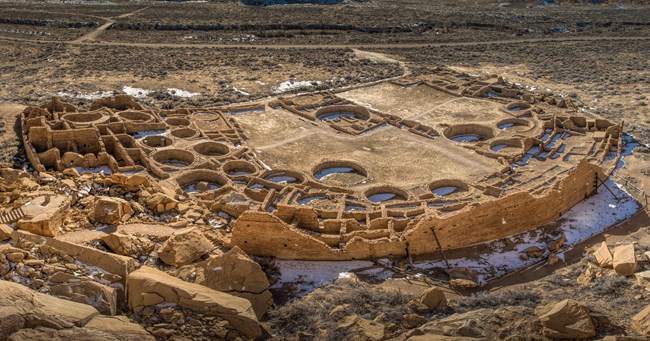
Andrew Kearns The Center of Chacoan CultureFor all the wild beauty of Chaco Canyon's high-desert landscape, its long winters, short growing seasons, and marginal rainfall create an unlikely place for a major center of ancestral Puebloan culture to take root and flourish. Yet this valley was the center of a thriving culture a thousand years ago. The monumental scale of its architecture, the complexity of its community life, the high level of its community social organization, and its far-reaching commerce created a cultural vision unlike any other seen before or since. The cultural flowering of the Chacoan people began in the mid 800s and lasted more than 300 years. We can see it clearly in the grand scale of the architecture. Using masonry techniques unique for their time, they constructed massive stone buildings (Great Houses) of multiple stories containing hundreds of rooms much larger than any they had previously built. The buildings were planned from the start, in contrast to the usual practiced of adding rooms to existing structures as needed. Constructions on some of these buildings spanned decades and even centuries. Although each is unique, all great houses share architectural features that make them recognizable as Chacoan. During the middle and late 800s, the great houses of Pueblo Bonito, Una Vida, and Peñasco Blanco were constructed, followed by Hungo Pavi, Chetro Ketl, Pueblo Alto, and others. These structures were often oriented to solar, lunar, and cardinal directions. Lines of sight between the great houses allowed communication. Sophisticated astronomical markers, communication features, water control devices, and formal earthen mounds surrounded them. The buildings were placed within a landscape surrounded by sacred mountains, mesas, and shrines that still have deep spiritual meaning for their descendants. By 1050, Chaco had become the ceremonial, administrative, and economic center of the San Juan Basin. Its sphere of influence was extensive. Dozens of great houses in Chaco Canyon were connected by roads to more than 150 great houses throughout the region. It is thought that the great houses were not traditional farming villages occupied by large populations. They may instead have been impressive examples of "public architecture" that were used periodically during times of ceremony, commerce, and trading when temporary populations came to the canyon for these events. What was at the heart of this great social experiment? Pueblo descendants say that Chaco was a special gathering place where many peoples and clans converged to share their ceremonies, traditions, and knowledge. Chaco is central to the origins of several Navajo clans and ceremonies. Chaco is also an enduring enigma for researchers. Was Chaco the hub of a turquoise-trading network established to acquire macaws, copper bells, shells, and other commodities from distant lands? Did Chaco distribute food and resources to growing populations when the climate failed them? Was Chaco "the center place," binding a region together by a shared vision? We may never fully understand Chaco. In the 1100s and 1200s, change came to Chaco as new construction slowed and Chaco's role as a regional center shifted. Chaco's influence continued at Aztec, Mesa Verde, the Chuska Mountains, and other centers to the north, south, and west. In time, the people shifted away from Chacoan ways, migrated to new areas, reorganized their world, and eventually interacted with foreign cultures. Their descendants are the modern Southwest Indians. Many Southwest Indian people look upon Chaco as an important stop along their clans' sacred migration paths-a spiritual place to be honored and respected. 
Davis Hopi Tribe of Arizona Jicarilla Apache Nation, New Mexico Kewa Pueblo, New Mexico Mescalero Apache Tribe, New Mexico Navajo Nation, Arizona, New Mexico, and Utah Ohkay Owingeh, New Mexico Pueblo of Acoma, New Mexico Pueblo of Cochiti, New Mexico Pueblo of Isleta, New Mexico Pueblo of Jemez, New Mexico Pueblo of Laguna, New Mexico Pueblo of Nambe, New Mexico Pueblo of Picuris, New Mexico Pueblo of Pojoaque, New Mexico Pueblo of San Felipe, New Mexico Pueblo of San Ildefonso, New Mexico Pueblo of Sandia, New Mexico Pueblo of Santa Ana, New Mexico Pueblo of Santa Clara, New Mexico Pueblo of Taos, New Mexico Pueblo of Tesuque, New Mexico Pueblo of Zia, New Mexico Pueblo of Zuni, New Mexico Southern Ute Indian Tribe, Colorado Ute Mountain Ute Tribe, Colorado, New Mexico, and Utah Ysleta del Sur Pueblo of Texas |
Last updated: May 21, 2025
